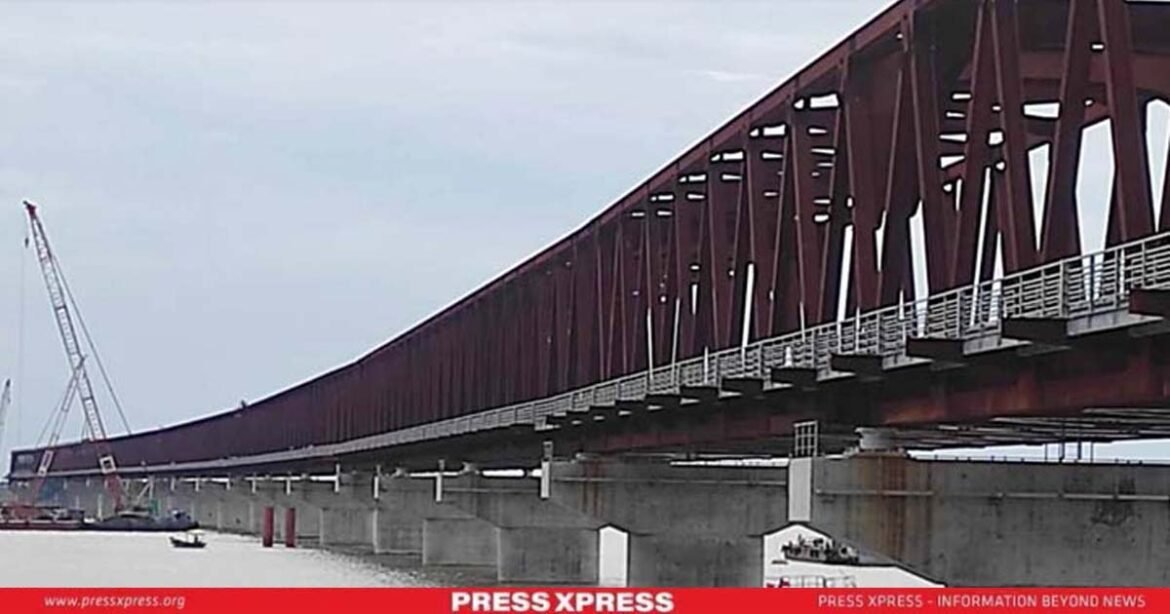The Bangabandhu Railway Bridge is now 86% completed, and almost ready to play a crucial part in Bangladesh’s growing economy. This impressive structure, stretching 4.8 kilometers over the mighty Jamuna River, is more than just a bridge; it’s a symbol of the nation’s forward momentum, linking Sirajganj and Tangail.
You can also read: Power Grid’s Q3 Profit Soars on Stable Exchange Rates
When the bridge is finished in 2024 (projected); it will dramatically improve connectivity, cutting down on travel times and sparking economic development. Being the country’s biggest railway bridge dedicated solely to rail traffic, its location is key to improving the flow of both goods and passengers. This bridge is poised to usher in a new chapter of financial growth and infrastructural prominence for Bangladesh within South Asia.
Specifications

The Bangabandhu Sheikh Mujib Railway Bridge, spanning 4.8 km over the Jamuna River, is a marvel of modern engineering. This dual-gauge, double-track bridge will revolutionize rail traffic between the capital and northwestern Bangladesh.
Built just upstream from the Bangabandhu Jamuna Multipurpose Bridge, this new structure will support trains traveling at 100-120 km/h, drastically improving upon the older bridge’s limitations. A collaboration between Bangladesh and Japan, the project’s budget has grown to Tk 16,780 crore (USD 1.98 billion), reflecting a commitment to infrastructure.
Initial Challenges and Cost Overruns
The Bangabandhu Sheikh Mujib Railway Bridge, while a mark of progress, faced financial challenges from the very beginning. Originally estimated at Tk 9,734 crore, the budget swelled to Tk 16,780 crore as planners encountered unforeseen requirements. This increase in costs wasn’t just about the figures; it reflected a series of hurdles, from engineering intricacies to environmental factors.
This financial journey illustrates not just a battle against monetary challenges but also the determination to secure a project that is vital for Bangladesh’s infrastructural aspirations. Despite these obstacles, the bridge stands as evidence of the country’s drive to create a future of improved connectivity.
Necessity of the Bridge
The new Bangabandhu Sheikh Mujib Railway Bridge acts as a vital lifeline, intended to ease the immense burden on its older counterpart, the Bangabandhu Multipurpose Bridge. Constructed in 1998, the bridge has had to severely limit traffic and train movement due to faulty design which prompted the government to sue Hyundai– the primary contractor of the bridge.
Currently, it can only support 38 trains daily, crawling along at a mere 20 km/h—a speed that hinders economic logistics, creating an ‘arterial chokepoint’. With train speeds significantly reduced to safeguard its weathered structure, the need for a separate bridge became absolute.
The new bridge tackles safety issues and was built with the limitations of the existing bridge in mind. As stated, the existing multipurpose bridge has developed cracks, raising concerns about its long-term stability. The new railway bridge not only provides a more secure path for trains but also alleviates the strain on the old structure, potentially prolonging its usable life and maintaining continued safety for road vehicles.
Connectivity Advantages

The Bangabandhu Sheikh Mujib Railway Bridge will be a powerful addition to Bangladesh’s rail system, bringing about remarkable connectivity improvements. The bridge is poised to significantly reduce travel times between the capital, Dhaka, and the northwestern regions of the country. Trains will soon speed across this structure at 100 to 120 km/h, a dramatic increase from the current 20 km/h limit on the existing Bangabandhu Multipurpose Bridge.
This improved speed and capacity translate into a stronger, more streamlined logistics network. The bridge will accommodate up to 88 trains per day, a notable increase from the present capacity, which allows for only 38 trains. This upgrade benefits not only passenger transportation but also enhances the movement of freight and cargo, which is vital for regional trade and business.
Furthermore, the completion of the bridge will create a direct, high-speed rail connection that is less vulnerable to the traffic jams and holdups that currently affect road travel. This dependability is essential for businesses and industries that depend on prompt deliveries, especially in the agricultural sector, where freshness is critical.
Economic Advantages of the Bridge
Once in operation, The Bangabandhu Sheikh Mujib Railway Bridge is anticipated to significantly cut down the time it takes to travel across the Jamuna River, thereby boosting the economic efficiency of freight transportation. Currently stymied by the faults and risks of the existing Multipurpose bridge.
This bridge will enable a more efficient movement of goods, especially agricultural products from the fertile regions to markets across Bangladesh and beyond. By enhancing logistics, reduces transportation costs and minimizes spoilage caused by delays, directly increasing the profitability of the agricultural and industrial sectors.

IIThe Sirajganj Economic Zone (Sez) is located right next to the Bangabandhu Sheikh Mujib Railway Bridge
Additionally, the bridge is a central component in the planned development of economic zones and industrial parks near Sirajganj and Bogura- the Sirajganj Economic Zone (SEZ) and BSCIC Industrial Park, which are expected to create jobs for around 1 million people. This growth is likely to draw in both local and foreign investment, further diversifying the region’s economic foundations and integrating it more extensively into global trade networks.
Conclusion
As it nears completion, the Bangabandhu Sheikh Mujib Railway Bridge represents a tremendous step forward for Bangladesh’s infrastructure and economic future. By enabling faster and more efficient rail transportation, this bridge is set to strengthen regional economies, improve connectivity, and optimize trade routes throughout the country and beyond.
The bridge’s completion will create new opportunities and better living standards for millions of people. The Bangabandhu Sheikh Mujib Railway Bridge is more than just a path across the water; it is a connection to a brighter, more thriving future for all of Bangladesh.


